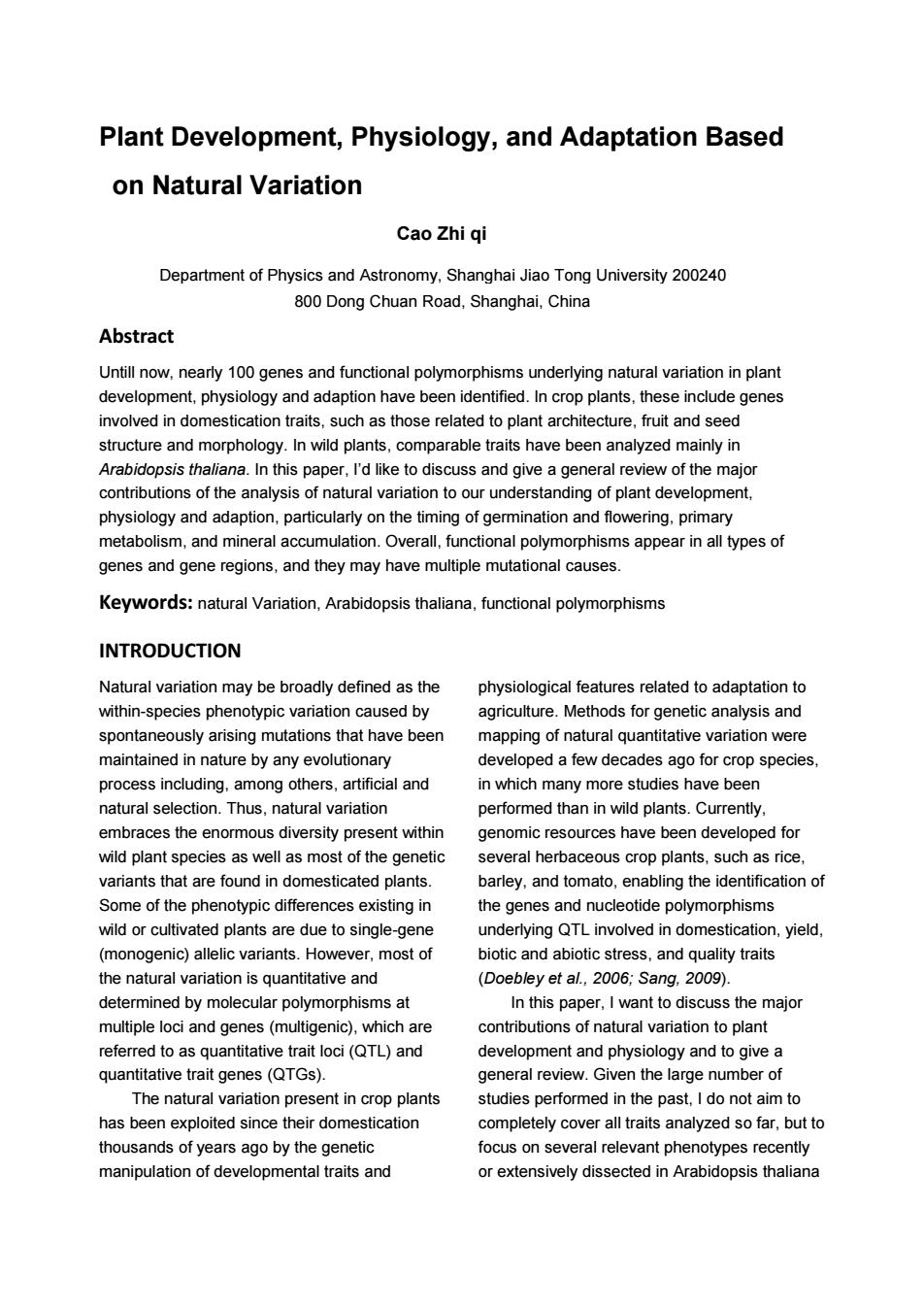正在加载图片...

Plant Development,Physiology,and Adaptation Based on Natural Variation Cao Zhi qi Department of Physics and Astronomy,Shanghai Jiao Tong University 200240 800 Dong Chuan Road,Shanghai,China Abstract Untill now,nearly 100 genes and functional polymorphisms underlying natural variation in plant development,physiology and adaption have been identified.In crop plants,these include genes involved in domestication traits,such as those related to plant architecture,fruit and seed structure and morphology.In wild plants,comparable traits have been analyzed mainly in Arabidopsis thaliana.In this paper,I'd like to discuss and give a general review of the major contributions of the analysis of natural variation to our understanding of plant development, physiology and adaption,particularly on the timing of germination and flowering,primary metabolism,and mineral accumulation.Overall,functional polymorphisms appear in all types of genes and gene regions,and they may have multiple mutational causes. Keywords:natural Variation,Arabidopsis thaliana,functional polymorphisms INTRODUCTION Natural variation may be broadly defined as the physiological features related to adaptation to within-species phenotypic variation caused by agriculture.Methods for genetic analysis and spontaneously arising mutations that have been mapping of natural quantitative variation were maintained in nature by any evolutionary developed a few decades ago for crop species, process including,among others,artificial and in which many more studies have been natural selection.Thus,natural variation performed than in wild plants.Currently, embraces the enormous diversity present within genomic resources have been developed for wild plant species as well as most of the genetic several herbaceous crop plants,such as rice variants that are found in domesticated plants. barley,and tomato,enabling the identification of Some of the phenotypic differences existing in the genes and nucleotide polymorphisms wild or cultivated plants are due to single-gene underlying QTL involved in domestication,yield, (monogenic)allelic variants.However,most of biotic and abiotic stress,and quality traits the natural variation is quantitative and (Doebley et al.,2006;Sang,2009). determined by molecular polymorphisms at In this paper,I want to discuss the major multiple loci and genes(multigenic),which are contributions of natural variation to plant referred to as quantitative trait loci(QTL)and development and physiology and to give a quantitative trait genes (QTGs). general review.Given the large number of The natural variation present in crop plants studies performed in the past,I do not aim to has been exploited since their domestication completely cover all traits analyzed so far,but to thousands of years ago by the genetic focus on several relevant phenotypes recently manipulation of developmental traits and or extensively dissected in Arabidopsis thalianaPlant Development, Physiology, and Adaptation Based on Natural Variation Cao Zhi qi Department of Physics and Astronomy, Shanghai Jiao Tong University 200240 800 Dong Chuan Road, Shanghai, China Abstract Untill now, nearly 100 genes and functional polymorphisms underlying natural variation in plant development, physiology and adaption have been identified. In crop plants, these include genes involved in domestication traits, such as those related to plant architecture, fruit and seed structure and morphology. In wild plants, comparable traits have been analyzed mainly in Arabidopsis thaliana. In this paper, I’d like to discuss and give a general review of the major contributions of the analysis of natural variation to our understanding of plant development, physiology and adaption, particularly on the timing of germination and flowering, primary metabolism, and mineral accumulation. Overall, functional polymorphisms appear in all types of genes and gene regions, and they may have multiple mutational causes. Keywords: natural Variation, Arabidopsis thaliana, functional polymorphisms INTRODUCTION Natural variation may be broadly defined as the within-species phenotypic variation caused by spontaneously arising mutations that have been maintained in nature by any evolutionary process including, among others, artificial and natural selection. Thus, natural variation embraces the enormous diversity present within wild plant species as well as most of the genetic variants that are found in domesticated plants. Some of the phenotypic differences existing in wild or cultivated plants are due to single-gene (monogenic) allelic variants. However, most of the natural variation is quantitative and determined by molecular polymorphisms at multiple loci and genes (multigenic), which are referred to as quantitative trait loci (QTL) and quantitative trait genes (QTGs). The natural variation present in crop plants has been exploited since their domestication thousands of years ago by the genetic manipulation of developmental traits and physiological features related to adaptation to agriculture. Methods for genetic analysis and mapping of natural quantitative variation were developed a few decades ago for crop species, in which many more studies have been performed than in wild plants. Currently, genomic resources have been developed for several herbaceous crop plants, such as rice, barley, and tomato, enabling the identification of the genes and nucleotide polymorphisms underlying QTL involved in domestication, yield, biotic and abiotic stress, and quality traits (Doebley et al., 2006; Sang, 2009). In this paper, I want to discuss the major contributions of natural variation to plant development and physiology and to give a general review. Given the large number of studies performed in the past, I do not aim to completely cover all traits analyzed so far, but to focus on several relevant phenotypes recently or extensively dissected in Arabidopsis thaliana